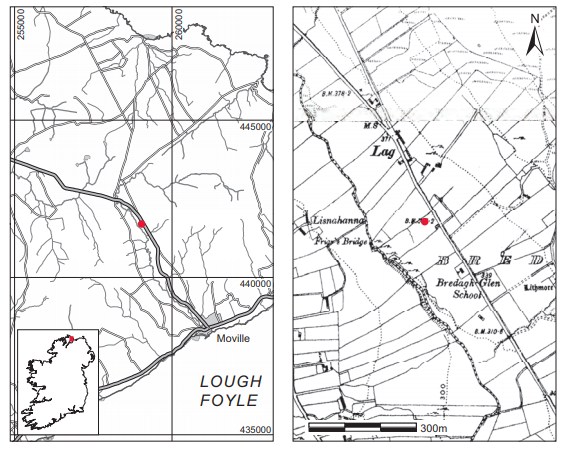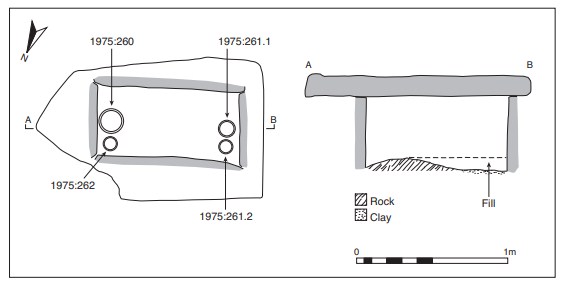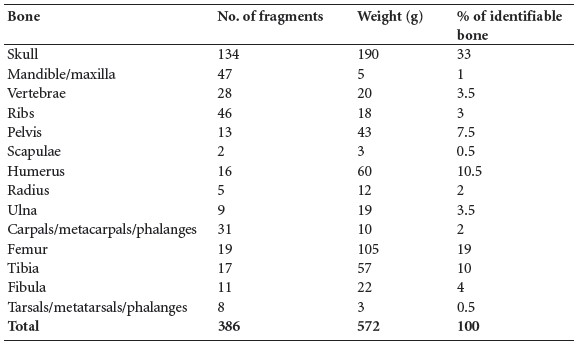County: Donegal Site name: BREDAGH GLEN, CO. DONEGAL
Sites and Monuments Record No.: SMR DG021-001 Licence number: E1048
Author: JOSEPH RAFTERY
Site type: Early Bronze Age graves
Period/Dating: —
ITM: E 658978m, N 941682m
Latitude, Longitude (decimal degrees): 55.218828, -7.073143
Introduction
During work in the garden of a dwelling house in late May 1975 a short cist containing a cremation and three vases was discovered near Moville, Co. Donegal. The site was reported to the NMI on 27 May 1975 by the Garda Síochána, and an investigation was carried out in June of that year by Dr Joseph Raftery. This report is based on the field sketches and notes made by Dr Raftery. The human remains were examined by Laureen Buckley.
Location (Fig. 3.29)
The cist was in the townland of Bredagh Glen, north-east Co. Donegal, on the eastern side of the Inishowen peninsula.48 It lay at an altitude of c. 90–120m above sea level. On the first edition OS 6in. map the site was in a very large open area, but on the second and third editions this area is divided into small strips of land. No similar sites are known in the vicinity.

Description of site
The cist was rectangular in internal plan, with its long axis aligned east-north-east/westsouth-west. Internally it measured 0.94m long by 0.43m wide by 0.54m high (Fig. 3.30). It was formed of four principal slabs, one forming each wall. These slabs appear to have been similar in size, with a maximum thickness of 0.13m, maximum height of 0.54m and maximum length of 0.97m. The capstone was subrectangular with a maximum length of 1.33m, maximum width of 0.85m and maximum thickness of 0.12m. The floor of the cist seems to be partly formed by a rock which protruded into the enclosed area at the eastern end. The floor at the western end is noted as of clay. The original pit is not indicated on the plan.
The cist contained a cremation burial (1975:263.1) representing a minimum of two individuals (at least one female) and three bipartite vases, with the remains of a possible fourth vessel described on the plan as ‘remains of fourth pot’. A note on the plan reads ‘bones in smallest pot—Pot 3 [1975:262]. Otherwise bones concentrated at each end with a thin sprinkling over whole of bottom’. The plan shows that the largest pot (pot 2; 1975:260) and the smallest, pot 3, were placed beside one another at the eastern end of the cist, while the smaller pot 1 (1975:261.1) and the remains of pot 4 (1975:261.2; not illustrated) were placed together at the western end. The pots are noted on the plan as being upright, with pot 3 described as ‘sitting on side, facing 4’. The condition of pot 4 is such that no detail of form has survived.
During the examination of the cremation deposit a burnt flint plano-convex knife was discovered, but it is not known in which cremation deposit the knife was originally placed.

Pottery
Bipartite vase, 1975:260 (Fig. 3.31)
The fabric of this bipartite vase is fine with occasional visible quartzite grits, reddish to light brown in colour on the outside and shiny in appearance owing to the application of artificial hardener (as a conservation measure). The vessel has a darker reddish colour on the inside. It has a high shoulder, its sides sloping gradually from shoulder to base, and an everted rim with an expanded bevel. Both the shoulder and the rim have deep double grooves, and the shoulder has seven evenly spaced perforated lugs. The vessel is decorated from rim to base in uneven bands of incised herringbone pattern. It has some impressions on its surface, probably from grits lost in firing or possibly seed impressions.
Dimensions: H 13.5cm; ext. D rim 16.4cm; D base 6.9cm; avg. W rim 2cm.
Bipartite vase, 1975:261.1 (Fig. 3.31)
The fabric of this vessel, classified by Ó Ríordáin and Waddell (1993) as a bipartite vase, is fine and red to light pink in colour, with some quartz grits showing. It is high-shouldered and straight-walled above the shoulder, tapering sharply below it to about 1cm above the medium-sized flat base. The rim has an expanded bevel and a slight suggestion of being everted, and is decorated with an irregular herringbone pattern that occasionally continues inside the vessel. The decoration of the neck occurs in four bands divided by grooves. The first two bands are narrow and seem to be an attempt at a herringbone pattern. The pattern peters out on the third and largest band, and decoration here consists of diagonal grooves lying in the same direction as those on the band above. The final band is filled with vertical grooving. Below this the decoration seems to have been incised hatching, perhaps in some form of basketry. The vessel is badly damaged and incomplete and some of the surface is missing.
Dimensions: H 11.5cm; ext. D rim 14.7cm; D base 6.5cm; avg. W rim 1.4cm.
Bipartite vase, 1975:262 (Fig. 3.31)
This vessel was classified by Ó Ríordáin and Waddell (1993) as a bipartite vase. Its fabric is fine, very light brown on the outside with some pink to grey on the inside and some large quartz grits visible. The vessel is high-shouldered, with the sides gradually sloping to a narrow, flat base. The rim is slightly everted with an expanded bevel and is damaged in one place. The decoration consists of irregular rows of incised herringbone, which cover the outside of the vessel to about 3cm from the base. Here there is a broad band of irregularly interlocking hatched triangles.

This vessel has impressions on its surface, possibly grits lost in firing.
Dimensions: H 11.5cm; ext. D rim 13.2cm; D base 5.2cm; avg. W rim 1.4cm.
Plano-convex knife, 1975:263.2 (Fig. 3.31)
This plano-convex knife (or slug knife), probably of flint, is not quite complete, as it has lost both ends and some of the outer surfaces on both sides as a result of damage caused by heat from the cremation pyre. The colour varies from white to grey to blue/grey, and both surfaces have a glazed appearance. A black sooty deposit adheres to some areas. The dorsal surface has been extensively retouched. Some surface areas are cracked but the knife remains in one piece. Dimensions: L 4cm; max. W 2.14cm; max. T 0.6cm.
Comment
A sample of the cremated remains produced a date of 3530±50 BP,49 which calibrates to 2016–1739 BC. Brindley (2007, 257), in discussing the dating of the development of the vase typology, places the Bredagh Glen vessels towards the later phases of the stage 1 vase sequence, c. 1900 BC. Again, a comparison between the cist at Altaghaderry (this volume, pp 98–111) and Bredagh Glen is relevant: four and three bipartite vases respectively were deposited in each grave, although only two individuals were represented in the Bredagh Glen cist as compared to eleven in the Altaghaderry cist.
Woodman et al. (2006, 168–9) note that plano-convex knives of different types have been found in Ireland in both Neolithic and early Bronze Age funerary contexts. A similar but intact burnt knife (1977:2355) was found with cremated bone in a cist grave at Figary, Co. Donegal, in 1977. This site was not reported at the time of discovery and was not investigated, but the account of the finder accords with a stone-lined rectangular cist (Lacey 1983, 66).
HUMAN REMAINS
LAUREEN BUCKLEY
Introduction
The sample (1975:263.1) consisted of 5,070 fragments of cremated bone, weighing a total of 1,619g. The bone was a creamy white colour but several fragments were blackened by charcoal.
Table 3.15—Fragmentation of bone, 1975:263.1.

The fragmentation of the sample is given in Table 3.15. It can be seen that there is only a relatively small proportion of very large fragments and that the large fragments, more than 15mm in length, make up only 52% of the sample. The high proportion of medium-sized fragments is probably due to the bone having been disturbed and broken up in the process. There may have been a high proportion of large fragments originally. Unfortunately, with no record of how it was disturbed when it was found, there is no way of estimating whether the bone was disturbed in the past, perhaps by three burials being undertaken at different times, or whether all three burials occurred at the one time and fragmentation occurred at the time of discovery.
Identifiable bone
Owing to the lack of very large fragments a relatively low proportion of bone could be identified from this site. A total of 572g (35% of the total bone) was identified. The amount and proportion of the identified bone are presented in Table 3.16.
Table 3.16—Weights and percentages of identified fragments,1975:263.1.

Table 3.17—Proportion of the various parts of skeleton, 1975:263.1.

The main parts of the skeleton identified from this sample are summarised in Table 3.17. It can be seen that while the proportion of skull is higher than expected and the proportion of upper and lower limbs is only slightly lower than expected, there is a significant reduction in the amount of axial skeleton collected. The axial skeleton is the most fragile and the least likely to be collected when a cist is disturbed.
Description of identifiable features of the bones
Skull
Most of the fragments were fragments of calvarium with parietal, occipital and frontal bone present. There was a large fragment of occipital bone present, with both the internal and external occipital protuberance visible. The external occipital protuberance was not prominent and therefore the skull may have belonged to a female. There was a large fragment of frontal bone and two right orbits. The petrous portions from two right and one left temporal bones were present and the mastoid area from one temporal bone was present. Also present was a fragment of one zygomatic bone.
Dentition
There were a large number of tooth fragments but these were mostly root fragments. At least three lower adult molars and one upper molar were present
Vertebrae
The dens of the second cervical vertebra was present, as well as the bodies of four lower cervical vertebrae. There were several disarticulated articular surfaces from thoracic vertebrae and lumbar vertebrae. The right ala and part of the left ala of the first sacral vertebra were present.
Ribs
Mostly small fragments of shaft, but some fragments close to the head from at least three ribs were present.
Pelvis
The auricular surface of the right ilium was present, as well as other fragments from the body of the ilium. There were also fragments of iliac crest, and the posterior part of the left ilium behind the auricular surface was present. There was also a right ischium and a left ischium with part of the acetabulum visible.
Scapulae
Part of an acromial spine was present.
Humerus
The proximal end of a left bone with an almost complete humeral head was present, as well as part of another head and the proximal part of the shaft of a right bone. There were various other fragments of shaft, including fragments from the distal end and one fragment of the capitulum from the distal joint surface.
Radius
Fragments from the middle and distal third of the shaft were present.
Ulna
The distal third of an ulna with part of the joint surface was present, as well as other fragments of distal shaft from at least two bones. There were also fragments from the middle and upper parts of the shaft of at least two bones.
Metacarpals and phalanges
The shafts of six metacarpals, including most of a second and the head of a first, were present; the scaphoid bone was also present. There were also six proximal, three middle and eight distal hand phalanges.
Femur
One complete head and one fragmented head were present, as well as fragments of the distal joint surface. A neck and part of the proximal shaft, including the lesser trochanter, from a left femur as well as several other fragments of shaft were present. Fragments of the posterior surface with the linea aspera visible were present, as well as some fragments of distal shaft.
Tibia
All the fragments were shaft fragments, including a large fragment of the anterior shaft of a left tibia with part of the lateral and medial surfaces visible. There was another large fragment of the anterior shaft from near the proximal end and also part of the anterior tubercle from the right tibia. Fragments from near the distal end were also present.
Fibula
Fragments of shaft, including fragments from the proximal, middle and distal areas.
Tarsals/metatarsals
At least one talus, one navicular and one foot phalanx.
Minimum number of individuals
The minimum number of individuals present appears to be two. They were both adults and at least one was a female.
Summary and conclusions
This was a large sample of efficiently cremated bone weighing 1,619g. The bone was moderately fragmented but this was probably due to disturbance of the cist or to its reuse at various times in the past. Most skeletal elements were present and at least two individuals were identified. Both were adults and at least one was a female.
48. Parish of Moville Lower, barony of Inishowen East. SMR DG021-001——. IGR 259039 441701.
49. GrA-14642.